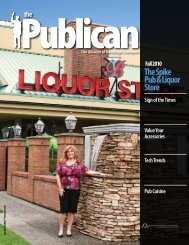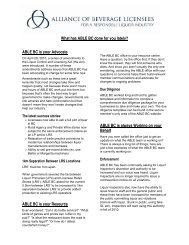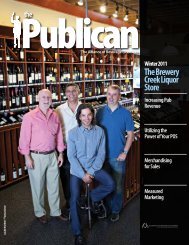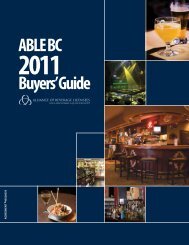Here - ABLE BC
Here - ABLE BC
Here - ABLE BC
You also want an ePaper? Increase the reach of your titles
YUMPU automatically turns print PDFs into web optimized ePapers that Google loves.
Human Resources<br />
by Shane Isley and Donnie Staff<br />
Good Job Descriptions Can Save You Time and Money<br />
Why Are Job Descriptions Important?<br />
Bringing out the best in your employees, and continuing to meet your business<br />
goals, starts with the development of thorough job descriptions. A good job<br />
description will provide employees with clear expectations, and can also<br />
take the place of more expensive and time-consuming training. Well-written<br />
job desciriptions can add value to many parts of your business. A good job<br />
description can: (1) help attract a strong pool of candidates more efficiently<br />
by describing the qualities, qualifications, and experience required to be<br />
successful in the position; (2) guide your training and development, ensuring<br />
your managers focus only on the skills & knowledge the employee needs<br />
to do the job; and (3) enable your managers to engage in meaningful and<br />
productive performance conversations with their direct reports. Well writtten<br />
job descriptions, while typically underrated, can be one of the most influential<br />
contributions to your business success.<br />
How to Create a Good Job Description<br />
Step 1: Mapping The starting point for writing a good job description is<br />
“mapping” the position. This helps you identify what someone serving in a<br />
position is expected to accomplish and whom they are expected to deliver work<br />
products to. Mapping a position requires an understanding of the company’s<br />
culture as well as the duties, responsibilities, and demands of the position. It<br />
also requires a familiarity with the position, specifically, knowledge of whom<br />
the employee will interact with both inside and outside the business. Before<br />
you begin mapping a position, it’s important to specify the position you<br />
wish to describe and not a person you want to convey information to (e.g.,<br />
write a job description for your pub’s head bartender, not for Peter the head<br />
bartender and manager). After you have specified the position, identify all of<br />
the people that expect to receive work products from the employee, including<br />
co-workers (internal customers) as well as customers, vendors, and partners<br />
(external customers). Your mapping assignment is complete once you identify<br />
the position's work products and which internal and external customers they<br />
are delivered to.<br />
Below are some tips for selecting work products.<br />
A work product is:<br />
• A product of behaviour, not a behaviour itself<br />
• A thing, not the measure of a thing<br />
• A valuable contribution to business results<br />
• A noun, not a verb<br />
Tips for writing work products:<br />
• Add criteria to help clarify what counts as an acceptable work product.<br />
• Ask yourself if you can state the work product in a plural tense. If so, then it is<br />
likely you have identified a countable noun that will function as a work<br />
product.<br />
Step 2: Defining The second step in writing a job description involves describing<br />
why the work products are important to the business as well as stating the<br />
criteria for an acceptable one. In order to show how work products contribute to<br />
the business’ overall success, link the work products to business results. Business<br />
results are the metrics a company uses to measure its success as a business,<br />
(e.g. profit margins, customer satisfaction, employee turnover, marketshare,<br />
etc.). Once you have shown the link between work products and business<br />
results, detail the criteria for what constitutes an acceptable work product. A<br />
list of criteria allows an employee and his manager to evaluate the quality of<br />
the employee’s work product(s) more easily.<br />
Lastly, list the actions or approaches recommended to complete each work<br />
product. Providing an employee with guidance as to how to produce work<br />
products can help ensure they follow company policies, engage in best practices,<br />
and are on track to becoming a more independent team member. Continue<br />
to link work outputs to business results, detail performance criteria and list<br />
actions until you have described all of the major work products for the position.<br />
Below is an example of one item, out of several, you may find on a store, pub,<br />
or bar manager’s job description.<br />
Business Results<br />
Work Product<br />
Criteria<br />
Behaviour<br />
Revenue streams<br />
Customer satisfaction<br />
Profit margin<br />
Cash flow<br />
Purchase order<br />
Includes the appropriate amount<br />
of supplies for the current business<br />
needs<br />
Replenishes inventory<br />
Establishes supplies to meet future<br />
customer demands, expected future<br />
sales, and daily sales goals<br />
Expands selection based on customer<br />
habits and current business plans<br />
Requests needed supplies at the<br />
lowest possible cost<br />
Placed in a timely manner so<br />
that stock is not depleted before<br />
purchased items are received<br />
Includes the business’ license number<br />
Is signed<br />
Research vendor costs and selection<br />
Take inventory of current stock<br />
Review past sales data<br />
Predict future sales<br />
Submit purchase order<br />
Shane Isley is President<br />
and Donnie Staff is VP of<br />
Consulting Services at Optimal.<br />
They can be reached at<br />
206-905-4660<br />
©2013 West Coast Behavioral<br />
Consultants, Inc. All Rights<br />
Reserved.<br />
The Publican<br />
31









